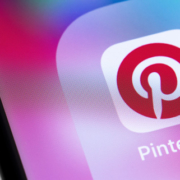We think Pinterest is probably one of the best ways to diversify your digital marketing strategy, but knowing your audience is key to getting ahead with this visual social platform. Pinterest is home to over 150 million active accounts and over 10,000 pins. It’s one of the largest social networks, and the predominant base conducts tons of product research using images and links.
Most online stores have Pinterest as part of their social management strategy, but there are so many other possible ways to use this platform to bring in sales and traffic.
If you don’t think the lifestyle social network is worth it, Pinterest generated $300 million in revenue and continues to grow its position each year. Pinterest has also updated its ads platform so now ads now stream beside regular posts, making it difficult for users to tell what is sponsored and what is organic. This has given advertisers a bigger boost in clicks and CTR.
Can Pinterest Help Your Marketing Goals?
Did you know that 87 percent of Pinterest users have purchased a product they found on Pinterest? Most marketers set up social media ads to build awareness and acquire customers, but it takes a lot to set up product pages, landing pages, conversion tracking and so forth. Pinterest Ads work a bit differently.
You can use Pinterest advertising throughout your entire marketing funnel, whether you want to create awareness or make a sale. This is because Pinterest caters to people searching for lifestyle products, fashion, beauty, furniture, and just about every other product category.
People use Pinterest to shop and plan, so they are already looking for solutions and products that will help them. One case study on Living Royal, a socks company, showed how using promoted pins can building upon awareness. After one month of investing in promoted pins, which is Pinterest’s most basic ad format, Living Royal tracked six times the amount of referral traffic. The conversion rate for promoted pins was also 40 percent higher in comparison to other advertising channels.
Pinterest also created a visual search tool that allowed users to look for products just with photos snapped on their mobile phones. This meant that if your products matched a photo, Pinterest would suggest them to the user, and they could click on the photo and the link, as long as your business had set up a page with products and photos.
Whether you want to increase brand awareness, sell more products, launch a new line, or simply reach a new market, there are a ton of ways to use Pinterest and achieve these goals.
Who Can You Reach with Ads on Pinterest?
The main audience on Pinterest includes affluent young women of adult age who typically make more than $75,000 a year. In addition, 10 percent of the social platform’s users make more than $125,000 per year. Active pinners were also noted to have 9 percent high incomes than others.
Pinterest has been working on expanding to male interests, but the best way to see if your audience is available is by using the Pinterest for Business platform and setting up an ad to build an audience.
Most of the Pinners on the platform are under 40 years of age. About 33 percent of users are over 40 years old.
With all that said, you can still target just about any demographic or interest on Pinterest’s advertising platform. Their targeting is almost as sophisticated as Facebook – you have the capability of targeting based on location, gender, age, search terms and more. There’s a lot of flexibility when it comes to the Pinterest Ads platform.
You can also upload audience lists with phone numbers and emails. Marketers typically pull this information from your CRM and upload it to the Pinterest Ads manager as a CSV. Pinterest will match any profiles with the same email or phone number.
With the Pinterest tag, you can also track all those who clicked and abandoned a sale, which allows you to build remarketing and loyalty campaigns. The Pinterest tag allows you to track the following:
- Page visits
- Category views
- Searches on your website
- Add to cart
- Watched video
- Sign-ups
- Leads
- Custom events
Pinterest supports custom conversion reporting, so you can see a breakdown of campaigns and how well they perform according to your conversion tracking. This is beneficial if you want to understand how different audiences respond to your campaigns, as well as what images and ad formats work best.
Why Pinterest Works Best for eCommerce
Want to boost your conversion rate? The experts say that images increase your conversion rates. That works well for Pinterest, where businesses and users pin, collect and share new products and ideas almost exclusively through images and links.
Pinterest released figures that showed their users spend 50 percent more on average in comparison to shopping through other social channels. They also spend 20 percent more than the users referred from non-social platforms, such as search engines. Other studies show that most Pinterest users go on the platform to research products that they plan to buy.
Based on this data, it’s safe to assume that Pinterest is a starting point for purchases online. In one case study from Ezra Firestone, the famous marketer generated almost $22,000 in revenue from just 520 sales and spending only $775.50 on Pinterest advertising.
Since Promoted Pins are shown right next to the organic content, many users click on the ads simply because of their appeal. In another study on Pinterest, it was found that 70 percent of sales from Promoted Pins were also new customers.
All of this boils down to the fact that online stores can get a lot of exposure and new business from simply promoting some of their pins. While you need to set up your pins to include high-quality images with links to the product pages, you can create endless boards and pins that connect to your site. As proven by Ezra Firestone, you also do not need that big of a budget to get a return.
Do Pinterest Ads Work?
Pinterest can be a very effective way to advertise certain products that would appeal to the social platform’s main userbase. Pinterest was built upon the idea that you can perform all kinds of research for products ranging from beauty and makeup to hairstyles to fashion to bohemian furniture and then some. In fact, Pinterest users are 47 percent more likely to be introduced to brand new products than users on any other social platform.
There are also a variety of formats and ways for users to interact with your pins, including:
- Promoted Pins: You can upload as many boards and pins as you like to your business’ Pinterest page. You can promote some of these with a small budget. That will increase your brand awareness and draw more traffic to your profile and links attached to your pins.
- Rich Pins: There are six types of “Rich Pins,” which ads dynamic information to the pin such as pricing, availability, and purchasing details for “Product Pins.” There are also recipe pins, article pins, place pins, movie pins, and app pins.
- Image or Video formats: Most advertisers should stick with images as promoted pins and organic pins look very similar when just a simple graphic is used. However, you can stand out with a video or GIF.
- Multiple Placements: Ads are placed in your profile, within search results, in relevant categories, and on a user’s home feed if they follow you or it’s relevant to their interests.
Most companies report that they see an increase in web traffic, conversions, transactions and revenue by using Pinterest to sell products that appeal to women.
Why not conduct a small advertising test? It may even help to simply set up your Pinterest for Business account and add your products as images. If you’d like additional help or set up a consultation to see if Pinterest Ads are right for your business, contact us.










